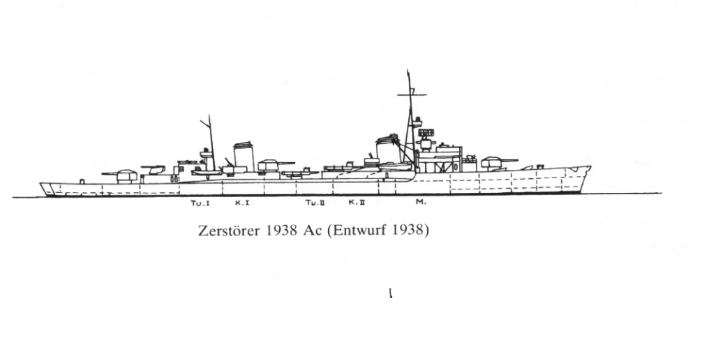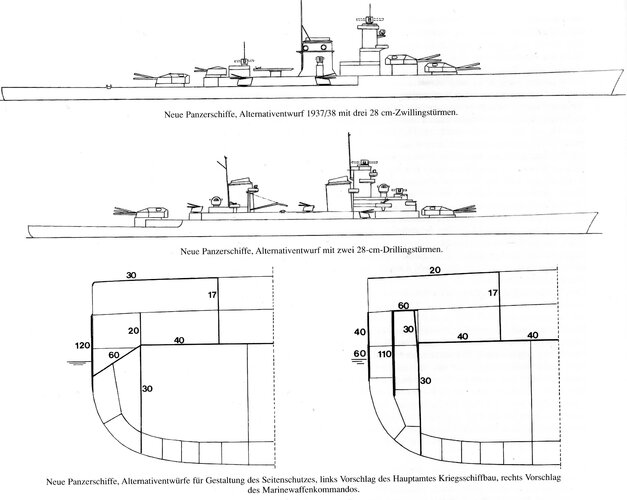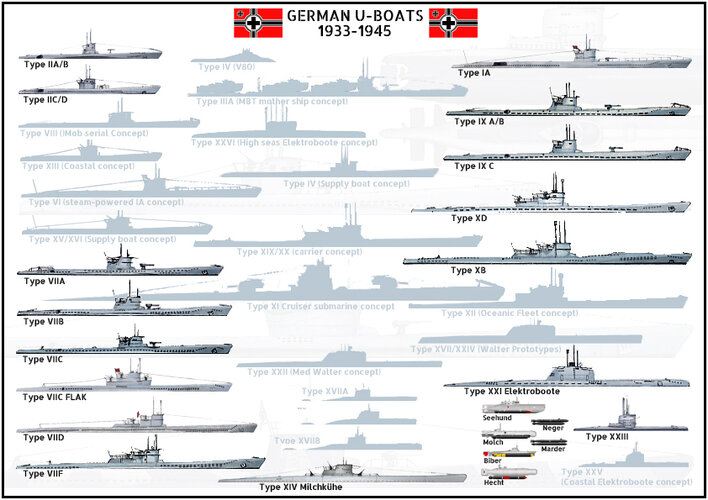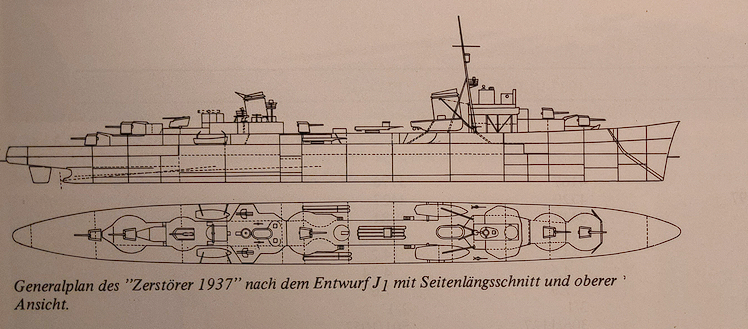You are using an out of date browser. It may not display this or other websites correctly.
You should upgrade or use an alternative browser.
You should upgrade or use an alternative browser.
Kriegsmarine - KM Ship Plans/Discussion
- Thread starter _Sarcasticat_
- Start date
You mean the I/35? am thinking Kriegsmarine would operate her like how they did with old pre-dreadnoughts, having a bigger punch are certainly worth it (the original purpose of I/35 was to use long-range 35cm bombard against French ports and their aging battleships something like that).Zenker Monitor
Thanks for the vote of confidence, Alexi. FWIW, I'm collecting some of the information gathered here for an eventual version 2.0. I have a couple of other projects in the meantime.Beyond H-41, they're mostly speculated, you can look up here.
MrMemerMan
ACCESS: Restricted
- Joined
- 11 June 2020
- Messages
- 47
- Reaction score
- 41
Does anyone happen to have blueprints to Zerstörer 1938A/Ac?
The source of the preliminary P-class are founded in RM7 "Seekriegsleitung der Kriegsmarine" but its non digitalize, two more files mentioned about mysterious armored ship "F" plans and preliminaries (later into battleship "F").
Thank you. If it is deemed possible, I can post a part of the text from S.Breyer's book, "Schlachtschiffe und Schlachtkreuzer 1921 - 1997", describing the evolution of Panzerschiff P and subsequent Handelszerstorer projects.The source of the preliminary P-class are founded in RM7 "Seekriegsleitung der Kriegsmarine" but its non digitalize, two more files mentioned about mysterious armored ship "F" plans and preliminaries (later into battleship "F").
Do you know anything about u-boots type XII,XIX or XX?
Type XII Large U-boat project
A fleet U-boat design from 1938. 8 torpedo tubes, 6 at the bow and 2 at the stern, all below the CWL. This boat was to carry 20 torpedoes and no mines. The gun armament was to be the same as for the type IX boats. No contracts granted for these boats.Type XIX freighter U-boats
Designed by the OKM from the XB plans in late 1942. Those large vessels were nor armed with any offensive armament, only AA guns, as they were only for transportation of material. Those plans were preliminary for the type larger XX U-boats and no contracts were awarded.Type XX freighter U-boats
Designed in 1943 by AG Weser and the OKM (German Navy High Command) as transport U-boats to carry material from the Far East. They were based on the type XB mine layers. They could carry 800 tons of material and they had no torpedo tubes and no deck gun, only AA armament. They were to have a crew of 6 officers and 52 men. 30 contracts granted, 15 to Deutsche Werft in Hamburg (U-1601 thru U-1615) and 15 more (U-1701 thru U-1715) to Vegesacker Werft in Bremen-Vegesack. Of those 30 contracts only 3 (U-1701 thru U-1703) were continued after 15 Aug 1944, but none was completed and their construction was halted in early 1945.
source: https://uboat.net/
lukasgrul
ACCESS: Confidential
- Joined
- 15 May 2021
- Messages
- 131
- Reaction score
- 112
Thank you for answering. I found these shipbucket drawings of type XII, do you think it is realistic?Do you know anything about u-boots type XII,XIX or XX?Type XII Large U-boat project
A fleet U-boat design from 1938. 8 torpedo tubes, 6 at the bow and 2 at the stern, all below the CWL. This boat was to carry 20 torpedoes and no mines. The gun armament was to be the same as for the type IX boats. No contracts granted for these boats.
Type XIX freighter U-boats
Designed by the OKM from the XB plans in late 1942. Those large vessels were nor armed with any offensive armament, only AA guns, as they were only for transportation of material. Those plans were preliminary for the type larger XX U-boats and no contracts were awarded.
Type XX freighter U-boats
Designed in 1943 by AG Weser and the OKM (German Navy High Command) as transport U-boats to carry material from the Far East. They were based on the type XB mine layers. They could carry 800 tons of material and they had no torpedo tubes and no deck gun, only AA armament. They were to have a crew of 6 officers and 52 men. 30 contracts granted, 15 to Deutsche Werft in Hamburg (U-1601 thru U-1615) and 15 more (U-1701 thru U-1715) to Vegesacker Werft in Bremen-Vegesack. Of those 30 contracts only 3 (U-1701 thru U-1703) were continued after 15 Aug 1944, but none was completed and their construction was halted in early 1945.
source: https://uboat.net/
Attachments
Hi Alexi.About the H-39/42 design i replied last months, it's possibly the redesign of H-41 battleship.
Yes, I agree, this sounds like the 15 Nov 1941 redesign that Dulin & Garzke mentioned. (pg 320)
_Sarcasticat_
Die Katze.
- Joined
- 16 April 2020
- Messages
- 364
- Reaction score
- 351
I might have had some a while ago, but someone borrowed the plans from the archive and they were not returned when I checked.Does anyone happen to have blueprints to Zerstörer 1938A/Ac?
MrMemerMan
ACCESS: Restricted
- Joined
- 11 June 2020
- Messages
- 47
- Reaction score
- 41
Dang.I might have had some a while ago, but someone borrowed the plans from the archive and they were not returned when I checked.Does anyone happen to have blueprints to Zerstörer 1938A/Ac?
_Sarcasticat_
Die Katze.
- Joined
- 16 April 2020
- Messages
- 364
- Reaction score
- 351
There should be two images of Europa in the folder.
_Sarcasticat_
Die Katze.
- Joined
- 16 April 2020
- Messages
- 364
- Reaction score
- 351
Hello everyone.
I plan to post a series of pictures of German destroyers and rangefinders. These pictures are screenshots and photographs of line drawings from many sources (Z-Vor, Marine-Archiv, etc) (not copies of 'real' photos taken of the destroyers - yet). There are several dozen images in total and were taken at the request of Tzoli. I figured since I did all that work, it might be good to further distribute. I'm not sure who it'll really benefit or why it would benefit them even if it did, but I'm sure someone will find them interesting. They are mostly Type 1934-1936B destroyers, FuMO 24/25 & FuMO 63 Hohentweil-K and Flakleitgerat M42 drawings with some Flottentorpedoboote sprinkled in there.
Of slightly more interest, I am sure, is that I also intend to upload plans of various German destroyers (1934A and 1936 mostly, but these two classes are the most representative anyway).
This will not happen for at least a week, but the intention is there.
As usual, I will post again when everything has been good and uploaded - links included.
Thank you for your time.
I plan to post a series of pictures of German destroyers and rangefinders. These pictures are screenshots and photographs of line drawings from many sources (Z-Vor, Marine-Archiv, etc) (not copies of 'real' photos taken of the destroyers - yet). There are several dozen images in total and were taken at the request of Tzoli. I figured since I did all that work, it might be good to further distribute. I'm not sure who it'll really benefit or why it would benefit them even if it did, but I'm sure someone will find them interesting. They are mostly Type 1934-1936B destroyers, FuMO 24/25 & FuMO 63 Hohentweil-K and Flakleitgerat M42 drawings with some Flottentorpedoboote sprinkled in there.
Of slightly more interest, I am sure, is that I also intend to upload plans of various German destroyers (1934A and 1936 mostly, but these two classes are the most representative anyway).
This will not happen for at least a week, but the intention is there.
As usual, I will post again when everything has been good and uploaded - links included.
Thank you for your time.
Last edited:
_Sarcasticat_
Die Katze.
- Joined
- 16 April 2020
- Messages
- 364
- Reaction score
- 351
Today I learned that Scharnhorst's overall machinery plant is rather small when compared to Derfflinger's, and that if you reduced the amount of E-Werke rooms you could fit Graf Zeppelin's machinery in the space.
_Sarcasticat_
Die Katze.
- Joined
- 16 April 2020
- Messages
- 364
- Reaction score
- 351
I'm hardly any better here with such slow internet, but this is as far as I've reached.Any idea how to access Krupp Archive files?, i have hard time to navigate the site.
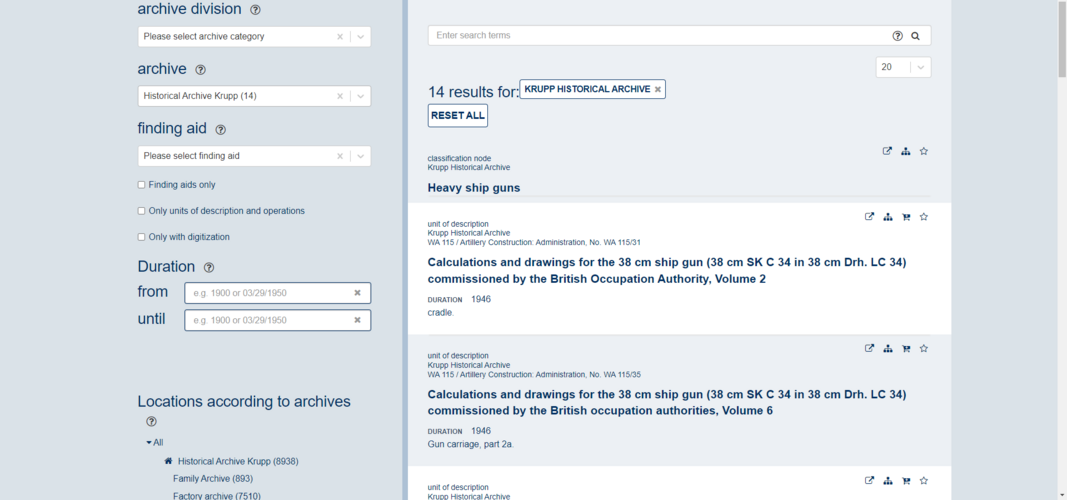
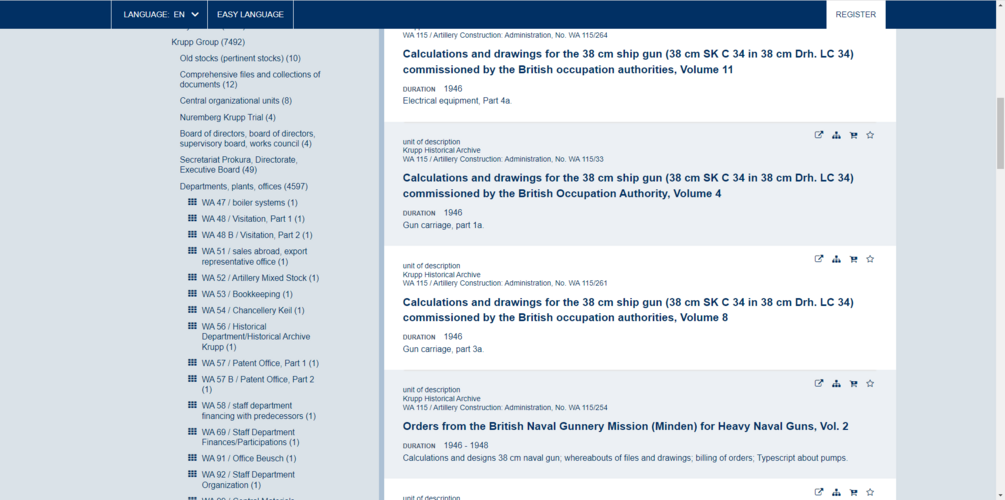
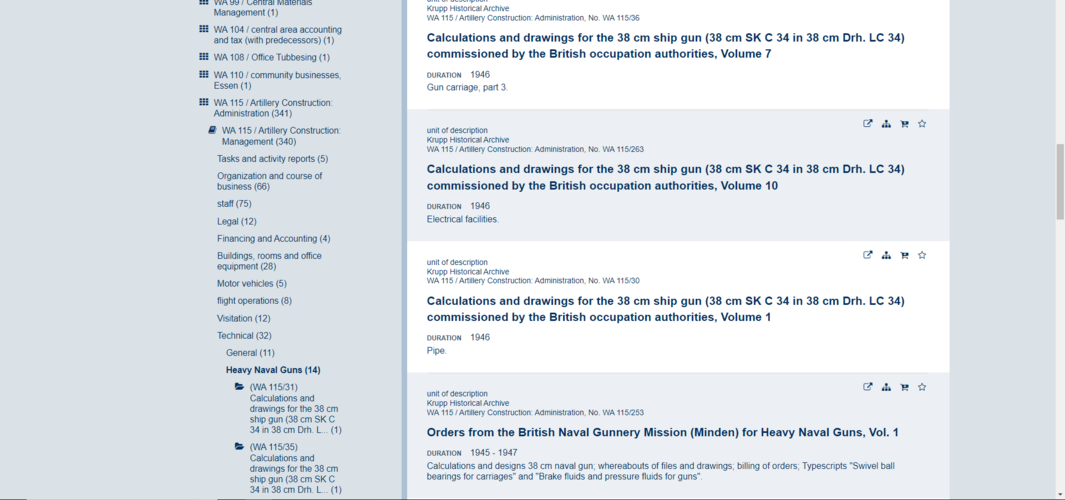
There is certainly more to find.
Archivsuche | Archive in Nordrhein Westfalen |
 www.archive.nrw.de
www.archive.nrw.de
Last edited:
_Sarcasticat_
Die Katze.
- Joined
- 16 April 2020
- Messages
- 364
- Reaction score
- 351
Unfortunately this is the closest I have to any sort of plan. Even so, this is not too bad.View attachment 700992 And then there is this on page 9 of this forum.
_Sarcasticat_
Die Katze.
- Joined
- 16 April 2020
- Messages
- 364
- Reaction score
- 351
I do but that will have to wait a few more days.Do you have blueprints of Graf Zeppelins armor scheme?
Well, I have an armor scheme drawing.
Last edited:
lukasgrul
ACCESS: Confidential
- Joined
- 15 May 2021
- Messages
- 131
- Reaction score
- 112
_Sarcasticat_
Die Katze.
- Joined
- 16 April 2020
- Messages
- 364
- Reaction score
- 351
Good day everyone.
As promised approximately a week ago, the German destroyer/Ftb/radar/director line drawings.
@lukasgrul Included is the armor scheme of Graf Zeppelin.
 drive.google.com
drive.google.com
Almost forgot the German DD plans.
 drive.google.com
drive.google.com
As promised approximately a week ago, the German destroyer/Ftb/radar/director line drawings.
@lukasgrul Included is the armor scheme of Graf Zeppelin.
Line Drawings - Google Drive
 drive.google.com
drive.google.com
Almost forgot the German DD plans.
German DDs Unorganized - Google Drive
 drive.google.com
drive.google.com
Last edited:
- Joined
- 1 February 2011
- Messages
- 2,933
- Reaction score
- 3,611
You can use this old site, click on "ВООРУЖЕНИЕ" to see Emden armaments change over time.
So this russian site is only dedicated to German warships?
Dilandu
I'm dissatisfied, which means, I exist.
Yes.So this russian site is only dedicated to German warships?
MrMemerMan
ACCESS: Restricted
- Joined
- 11 June 2020
- Messages
- 47
- Reaction score
- 41
Seawarpeace is a very good place to look into German warships. However just be careful on what you read on there. Some of the information is a bitch sketchy or just straight up outdated.
I know.Seawarpeace is a very good place to look into German warships. However just be careful on what you read on there. Some of the information is a bitch sketchy or just straight up outdated.
- Joined
- 1 February 2011
- Messages
- 2,933
- Reaction score
- 3,611
In the mean time here is my drawing of the Flottentorpedoboote 1944 or T52 class based on official sketch:

The design had the following characteristics:
Dimensions: 98 (wl) x 103 (oa) x 10,1 x 3,07m
Displacement: 1.418ons (standard), 1.794tons (full load)
Engines: 52.000shp Wagner Steam Turbines, 2 shafts
Speed: 69km/h (37-37,5knots)
Range: 8.300km (4.500nm)
Armaments:
2x2 10.5cm/52 SK C/36 Guns,
5x2 3cm/73 SK C/30 AA Guns,
2x3 53cm Torpedo Tubes,
60x Mines
Sensors:
FuMo 24/25 (Above the rangefinder in front of the Mainmast)
FuMo 63 Hohentweil-K (Behind the 2nd funnel)
FuMo 231 Euklid (On the front of the Rangefinder FlakleitGerat M42)

The design had the following characteristics:
Dimensions: 98 (wl) x 103 (oa) x 10,1 x 3,07m
Displacement: 1.418ons (standard), 1.794tons (full load)
Engines: 52.000shp Wagner Steam Turbines, 2 shafts
Speed: 69km/h (37-37,5knots)
Range: 8.300km (4.500nm)
Armaments:
2x2 10.5cm/52 SK C/36 Guns,
5x2 3cm/73 SK C/30 AA Guns,
2x3 53cm Torpedo Tubes,
60x Mines
Sensors:
FuMo 24/25 (Above the rangefinder in front of the Mainmast)
FuMo 63 Hohentweil-K (Behind the 2nd funnel)
FuMo 231 Euklid (On the front of the Rangefinder FlakleitGerat M42)
Last edited:
Wow Sarcasticat. I do not know how you got the drawings, but wow and thank you. I have spent the last few years looking for information on Panzershiff Lutzow, and in 5 minutes bang.
Do you have any drawings for 1936A Mob destroyer or 1937 Type torpedo boat T13-T21?
Do you have any drawings for 1936A Mob destroyer or 1937 Type torpedo boat T13-T21?
_Sarcasticat_
Die Katze.
- Joined
- 16 April 2020
- Messages
- 364
- Reaction score
- 351
Hello Sask,Wow Sarcasticat. I do not know how you got the drawings, but wow and thank you. I have spent the last few years looking for information on Panzershiff Lutzow, and in 5 minutes bang.
Do you have any drawings for 1936A Mob destroyer or 1937 Type torpedo boat T13-T21?
I do this because when I was young...er...I was always in a situation where I couldn't find any of the plans I wanted, left asking or begging others. After being brushed off (many do not really care for the KM) several times (and for several years!), I decided to take matters in my own hands.
You can find digitized versions here on Bundesarchiv under RM 25 (this will initially lead you to Nurnberg iirc, and you can go from there).

I also contacted historical investigators who could bypass a lot of red tape and photo plans directly using their status, or could hook me up with digitized versions - for a cost.
As for Type 1936A...it's been a bit elusive, but I think I have a plan or two, and the same goes for the Type 1937's. You'll have to give me a few days to get you these images, but rest assured that I pull through much more often than most.
Last edited:
Similar threads
-
Kriegsmarine - KM Naval Armament Plans/Discussion
- Started by _Sarcasticat_
- Replies: 293
-
I-400 sized German U-boat projects from WW2?
- Started by Vahe Demirjian
- Replies: 9
-
-
-

